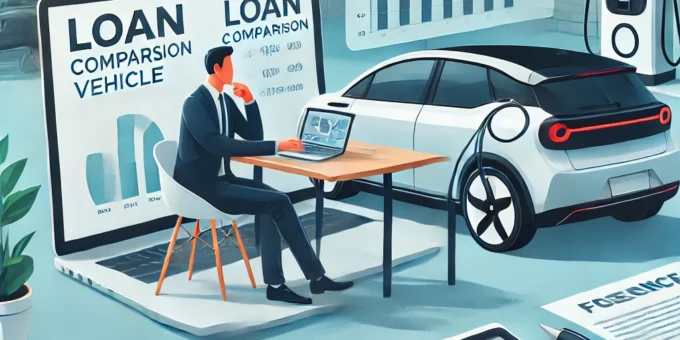
Electric vehicles (EVs) are rapidly becoming the preferred choice for eco-conscious drivers, thanks to their sustainability, lower maintenance costs, and innovative features. However, the higher upfront cost of EVs often prompts buyers to explore financing options. Electric vehicle loans are a great way to make these environmentally friendly cars more accessible.
In this guide, we’ll break down everything you need to know about EV loans, including how they work, the benefits of green financing, and tips for securing the best loan terms.
Introduction
Purchasing an EV can feel daunting due to the initial cost, but electric vehicle loans offer an affordable pathway to ownership. By understanding the nuances of EV financing, you can make an informed decision that suits your budget while maximizing incentives and minimizing costs.
This guide will walk you through the process of obtaining an EV loan, helping you make your dream of owning an electric vehicle a reality.
Why Choose an Electric Vehicle Loan?
- Spread the Cost: EV loans allow you to break the upfront cost into manageable monthly payments.
- Access Better Models: Financing can help you afford a higher-quality EV with advanced features.
- Leverage Incentives: Many loans come with favorable terms and are eligible for government rebates.
- Lower Ownership Costs: While EVs may cost more upfront, they save money on fuel, maintenance, and taxes over time.
How Do Electric Vehicle Loans Work?
EV loans function similarly to traditional auto loans, but they often come with added benefits tailored to eco-friendly vehicles.
Key Features of EV Loans
- Loan Amount: Covers the cost of the car minus your down payment.
- Interest Rates: Typically lower than standard auto loans, especially with green financing programs.
- Loan Term: Ranges from 36 to 72 months, with shorter terms offering lower interest rates.
- Incentives: Federal and state programs often reduce the total loan amount or interest.
Types of Lenders Offering EV Loans
- Banks and Credit Unions: Offer competitive rates for borrowers with good credit.
- Green Auto Loan Programs: Specifically designed for eco-friendly vehicles, often with better terms.
- Online Lenders: Provide convenience and quick approvals.
- Manufacturer Financing: Automakers like Tesla, Nissan, and Hyundai offer tailored financing options for their EVs.
Benefits of Electric Vehicle Loans
1. Lower Interest Rates
Many lenders offer green loans with reduced rates to encourage sustainable purchases.
2. Incentives and Rebates
Combining your loan with government programs can reduce costs significantly.
- Federal Tax Credits: Up to $7,500 for eligible vehicles in the U.S.
- State Rebates: Additional savings depending on your location.
- Utility Discounts: Some power companies offer rebates for EV purchases or home charging stations.
3. Flexible Terms
Choose loan terms that fit your budget, from shorter terms with higher payments to longer terms with lower monthly costs.
4. Long-Term Savings
EVs save you money on fuel, maintenance, and emissions-related taxes, making loans more affordable in the long run.
Steps to Secure an Electric Vehicle Loan
Step 1: Assess Your Financial Health
Before applying for a loan, evaluate your finances:
- Credit Score: A higher score qualifies you for better rates.
- Debt-to-Income Ratio: Lenders prefer a DTI ratio below 40%.
- Down Payment: Aim for at least 10%-20% of the car’s price.
Step 2: Research Loan Options
Compare offers from different lenders to find the best terms:
- Look for green auto loans with low interest rates.
- Explore manufacturer promotions or seasonal discounts.
- Use comparison tools like LendingTree or NerdWallet.
Step 3: Pre-Approval
Getting pre-approved for a loan simplifies the buying process and gives you a clear understanding of your budget.
Step 4: Choose the Right EV
Select a vehicle that fits your needs and qualifies for incentives.
- Research fuel efficiency, range, and maintenance costs.
- Look for models eligible for federal and state rebates.
Step 5: Submit Your Loan Application
Provide the required documents, including proof of income, ID, and vehicle details.
Green Auto Loans: What You Need to Know
Green auto loans are designed specifically for EVs and hybrids, offering several advantages:
- Lower Interest Rates: Encourages environmentally friendly purchases.
- Flexible Terms: Ranges from 36 to 72 months.
- Incentive Compatibility: Works seamlessly with federal and state rebates.
Where to Find Green Loans
- Credit Unions: Navy Federal, Alliant Credit Union.
- Banks: LightStream, Bank of America.
- Online Lenders: Platforms like Carvana or LendingTree.
Tips for Getting the Best EV Loan
- Improve Your Credit: Pay bills on time and reduce debt before applying.
- Save for a Down Payment: A larger down payment lowers your loan amount and interest costs.
- Choose a Shorter Loan Term: Save on interest with a 36- or 48-month term.
- Leverage Incentives: Use tax credits and rebates to reduce the loan principal.
- Shop Around: Compare at least three lenders to secure the best rates.
Common Mistakes to Avoid
- Skipping Loan Comparisons: Always compare offers from multiple lenders.
- Overextending Your Budget: Borrow only what you can comfortably repay.
- Ignoring Fine Print: Check for hidden fees, prepayment penalties, or variable interest rates.
- Delaying Applications: Incentives like tax credits may have deadlines—act quickly to take advantage.